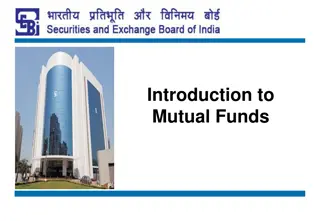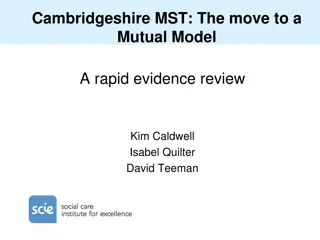Overview of UTI and LIC Mutual Funds in India
UTI (Unit Trust of India) and LIC (Life Insurance Corporation) are prominent players in the mutual fund industry in India. UTI was established in 1964 with a focus on savings and investment, offering various schemes like Income Plan, Growth Plan, and more. LIC Mutual Fund, founded in 1989, is known for its financial ethics and governance, providing a range of investment options. Both institutions aim to create value for investors and offer innovative strategies for all types of investors, backed by a commitment to customer satisfaction.
Download Presentation

Please find below an Image/Link to download the presentation.
The content on the website is provided AS IS for your information and personal use only. It may not be sold, licensed, or shared on other websites without obtaining consent from the author.If you encounter any issues during the download, it is possible that the publisher has removed the file from their server.
You are allowed to download the files provided on this website for personal or commercial use, subject to the condition that they are used lawfully. All files are the property of their respective owners.
The content on the website is provided AS IS for your information and personal use only. It may not be sold, licensed, or shared on other websites without obtaining consent from the author.
E N D
Presentation Transcript
Mutual Fund M. Maria Jessica, PG and Research Department of Commerce, BON SECOURS COLLEGE FOR WOMEN, Thanjavur.
Contents INSTITUTIONS INVOLVED IN MUTUAL FUND: - UTI - LIC - COMMERCIAL BANKS
INSTITUTION INVOLVED IN MUTUAL FUND
INTRODUCTION UTI was set up in 1964 by act of parliament. It commenced its operation from July 1964 with a view to encouraging saving and investment and participation in the income, profit and gain accruing to corporation from the acquisition, holding management and disposal of securities.
VARIOUS SCHEMES OF UTI FOR DIFFERENT CATEGORIES OF INVESTORS Income Plan Growth Plan Insurance Plan Systematic withdrawal Plan Reinvestment Plan Systematic Plan
Contd.. Income Plan : The mutual funds distribute a substantial part of the surplus to investors in the dividends. Example: UTI Gilt Fund. Growth Plan : An investors realize only capital appreciation on the investment and normally does not get any income in the form of income distribution. Investment Plan : Here, the accrued income is reinvested in the purchase of additional units. Systematic investment plan: The investor is given the option of managing investment on a periodical basis and thus inculcating a regular saving habit. He may issue pre determined date and among from the fund. Insurance plan: Here, the investors are given an insurance cover against life or personal accident . Example : Unit Linked Insurance Plan (ULIP)
LIC Mutual fund LIC Mutual Fund was established on 20th April 1989 by LIC of India. Being an associate company of India's premier and most trusted brand, LIC Mutual Fund is one of the well known players in the asset management sphere. With a systematic investment discipline coupled with a high standard of financial ethics and corporate governance, LIC Mutual Fund is emerging as a preferred Investment Manager amongst the investor fraternity. LIC Mutual Fund endeavors to create value for its investors by adopting innovative and robust investment strategies, catering to all segments of investors. LIC Mutual Fund believes in providing delight to its customers and partners by way of superior investment experience and unparalleled service thereby truly bring them Khushiyaan, Zindagi Ki.
LIC MUTUAL FUND SCHEMES/ PLANS LIC MF Banking & Financial Services Fund- Regular Plan LIC MF Banking & PSU Debt Fund LIC MF Bond Fund LIC MF Children s Gift Fund LIC MF Debt Hybrid Fund
CONTD. LIC MF Banking & PSU Debt Fund Direct Growth: The investment objective of the scheme is to provide reasonable possible current income - consistent with preservation of capital and providing liquidity - from investing in a diversified portfolio of short-term money market and debt securities. Returns are taxed as per your Income Tax slab, if sold before 3 years. Negligible Tax (20% with indexation benefit) post 3 years. LIC MF Bond Fund: Investment primarily in fixed Income securities.Returns are taxed as per your Income Tax slab, if sold before 3 years. Negligible Tax (20% with indexation benefit) post 3 years. The fund aims to generate reasonable returns for its Investors through
CONTD LIC MF Children s Gift Fund : The LIC MF Children's Gift Fund Direct Growth is rated Moderately High risk. Minimum SIP Investment is set to 1000. Minimum Lump sum Investment is 500. To generate long term capital appreciation through a judicious mix of quality debt and equity instruments at relatively low risk levels. If average equity holding is >65%, returns are taxed at 15% (redeemed before one year) and 10% (After 1 year as per LTCG). If average equity holding is <65%, returns are taxed as per your Income Tax slab (redeemed before 3 years) and 20% with indexation benefit (post 3 years).
COMMERCIAL BANKS AND MUTUAL FUNDS Banks can provide a wider range of products / services in mutual funds by introducing innovative schemes and extend their professionalism to the mutual funds industry. Banks , as merchant banks, have wide experience in the capital market and hence managing a mutual fund may not be a big problem for them. The entry of banks would provide much needed competition in the mutual industry which has been hitherto monopolized by the UTI. This competition will improve customer service and widen customer choice also.
CONTD In the Indian economy, the eighties witnessed the operation of both the process of intermediation and disintermediation. The disintermediation process can be easily harnessed by commercial banks through mutual funds. The process of disintermediation of time deposits into mutual funds would benefit the capital market because it would provide a sustainable domestic source of demand. Investor servicing can be effectively done by banks through their network of branches spread throughout the country. Hence, the commercial banks have entered into the mutual fund market without any hesitancy.























